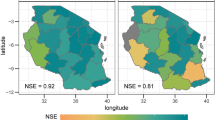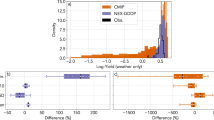Abstract
SOUTHERN Africa is subject to recurrent droughts which cause severe food shortages. There is considerable evidence1 that El Niño2 warm events in the Pacific Ocean are linked to below-average rainfall in southern Africa, and the 1991–92 El Niño event was accompanied by the worst drought in southern Africa this century, affecting nearly 100 million people. But although models can predict El ñ events a year in advance3–6, the drought was not anticipated, increasing relief costs. Here we present data show-ing a strong correlation between an El Niño index and both rainfall and maize yield in Zimbabwe. Surprisingly, the correlation with maize yield is stronger than that with rainfall, with more than 60% of the variance in yield accounted for by sea surface temperatures in the eastern equatorial Pacific Ocean—half-way around the world. We also show that model predictions of the El Niño index provide accurate forecasts of maize yield in Zimbabwe, with lead times of up to a year. As maize is the most important food crop for the ten-nation Southern African Development Community region7, we suggest that this approach could provide an effective early-warning system for southern African drought-induced famines.
This is a preview of subscription content, access via your institution
Access options
Subscribe to this journal
Receive 51 print issues and online access
$199.00 per year
only $3.90 per issue
Buy this article
- Purchase on Springer Link
- Instant access to full article PDF
Prices may be subject to local taxes which are calculated during checkout
Similar content being viewed by others
References
Ropelewski, C. F. & Halpert, M. S. Mon. Weath. Rev. 115, 1606–1626 (1987).
Philander, S. G. H. Nature 302, 295–301 (1983).
Latif, M. et al. Clim. Dynamics 9, 167–180 (1993).
Cane, M. A., Zebiak, S. E. & Dolan, S. C. Nature 321, 827–832 (1986).
Barnett, T. P. et al. Science 241, 192–196 (1988).
Cane, M. A. in Teleconnections Linking Worldwide Climate Anomalies (eds Glantz, M. H., Katz, R. W. & Nicholls, N.) 345–370 (Cambridge Univ. Press, 1991).
Food Balance Sheet (Food and Agricultural Organization (UN), Rome, 1991).
Zebiak, S. E. & Cane, M. A. Mon. Weath. Rev. 115, 2262–2278 (1987).
Neelin, J. D., Latif, M. & Jin, F. F. A. Rev. Fluid Mech. 26, 617–659 (1994).
Rimmington, G. M. & Nicholls, N. Aust. J. agric. Res. 44, 625–632 (1993).
Kerr, R. A. Science 255, 402 (1992).
Assessment of the Response to the 1991/92 Drought in the SADC region (SADC Food Security Technical and Adminstrative Unit, Harare, Zimbabwe, 1993).
Author information
Authors and Affiliations
Rights and permissions
About this article
Cite this article
Cane, M., Eshel, G. & Buckland, R. Forecasting Zimbabwean maize yield using eastern equatorial Pacific sea surface temperature. Nature 370, 204–205 (1994). https://doi.org/10.1038/370204a0
Received:
Accepted:
Issue Date:
DOI: https://doi.org/10.1038/370204a0
This article is cited by
-
Sugarcane Yield Forecasting Model Based on Weather Parameters
Sugar Tech (2021)
-
Larger-scale ocean-atmospheric patterns drive synergistic variability and world-wide volatility of wheat yields
Scientific Reports (2020)
-
Effect of Indian Ocean–Pacific SST Pattern in Autumn on Winter Wheat Climatic Yield in the North China Plain in the Following Year and a Possible Mechanism
Scientific Reports (2019)
-
Why do we have El Niño: quantifying a diabatic and nonlinear perspective using observations
Climate Dynamics (2019)
-
A metric for quantifying El Niño pattern diversity with implications for ENSO–mean state interaction
Climate Dynamics (2019)
Comments
By submitting a comment you agree to abide by our Terms and Community Guidelines. If you find something abusive or that does not comply with our terms or guidelines please flag it as inappropriate.



